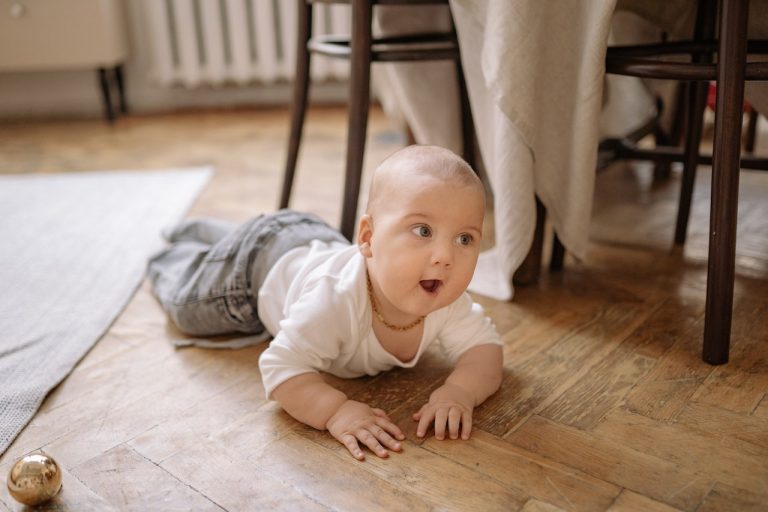
Exploring Mobility: A Deep Dive into the 7 Stages of Crawling and Your Role in It
- Created:
17. 10. 2023 - Updated:
9. 11. 2023
Get this:
From their first cry to their first steps, babies achieve various milestones that mark their development journey. While we expect these milestones, it’s always a wonder to see them coo, laugh, grip, sit, and even crawl.
Now:
Each milestone follows a process, and with crawling, there are seven different stages. But how do you scale through them with your baby?
Lucky for you:
We’re here for the ride. Buckle up as we discuss the 7 stages of crawling and your role in it.
The Importance of Crawling
Crawling is significant in babies because it contributes to their physical, cognitive, and sensory development. It accelerates their mobility, allowing them to explore their environment and strengthen their limbs in the process.
Furthermore:
Crawling is considered the first independent movement your baby will make between two points. To achieve this, they will learn to push themselves forward and upward, paving the way for future mobility like walking and running.
However:
To perform any crawl step, your baby must ideate it. As such, it greatly relies upon and helps improve their physical and neurological communication.
Thus, crawling bolsters babies’ coordination as they master and develop other motor skills.
But that’s not all.
Their spatial understanding and binocular vision are boosted when crawling. They become more aware of their environment, can lock eyes on an object, and determine the most efficient way to get to it.
Lastly:
As they continue to crawl and take risks, their confidence upticks, allowing them to learn of their abilities and limitations.
Now, let’s consider the various stages of crawling. Shall we?
Stage 1: Tummy Time
Tummy time refers to the practice of letting your baby spend time awake lying on their belly. It aids in strengthening the muscles in the neck, shoulders, arms, back, and torso. Movements such as rolling and pivoting during tummy time strengthen babies’ core muscles and enhance their spatial awareness.
Also:
The American Academy of Pediatrics states that this position reduces the risk of positional plagiocephaly—a condition in which a baby’s head has flat spots or looks uneven in certain areas.
Now:
Making tummy time a part of your baby’s wake windows is important, but your baby may not naturally conform to it. As such, starting them early, from as early as a few weeks, on tummy time establishes it as a long-term routine.
But note:
Never leave your baby to sleep in this position. At least, not yet. It could lead to Sudden Infant Death Syndrome. Also, not all babies feel comfortable during tummy time. So, if you notice a discomfort in your baby, place a rolled-up towel under their chest for a slight prop—this eases them.
Stage 2: Head Control
Fact:
Head control is an important step in your baby’s journey to crawling and other motor skills. At birth, your baby has very little head control.
But:
As they grow, their neck muscles strengthen. And by 4 months, a baby can control their neck muscles, according to MyHealth Alberta. In addition, Healthline says that from 3 to 6 months, babies master head control, which is the foundation for all their movements.
During the crawling process, your baby would need to balance and turn their head in order to navigate their surroundings.
Now:
While it is a necessary step in your child’s development, it doesn’t come easy for every baby. With patience and consistency, ensure to engage them in activities like tummy time and gentle stretch exercises. You can also encourage reaching and grabbing during playtime.
Stage 3: Rolling Over
Around 3 to 6 months, babies embark on the next step to crawling—rolling. Rolling is often triggered by a new-found curiosity about their surroundings and their desire to move around and grab objects.
Furthermore:
Rolling enables your baby to strengthen both sides of their body and muscles. It also causes them to be more aware of their own bodies and achieve greater balance. This aids future mobility as they’re stronger and have more control of their bodies.
So, what’s your role?
Engage them in various activities like leg cycling to improve their leg strength and coordination. Besides tummy time, you can help them practice reach and grab, but this time, with objects by their side.
Stage 4: Sitting Up
As you know:
Sitting up is an important developmental milestone that precedes crawling in a baby’s improvement of motor skills.
Now:
The journey to sitting up begins with lying down. And as time passes and core strength increases, babies are able to roll and, subsequently, sit up independently.
By sitting unassisted, your baby develops balance, core strength, spatial awareness, and will to turn to their sides to take a crawl position. It allows them to express their motor skills with minimal restriction.
Where do you come in?
Practice assisted sitting by propping them up with pillows. You can also use a Bumbo seat, a baby rocker, or a high chair. However, this must be under close supervision.
Stage 5: The Pre-Crawl Position (Bear Position)
News:
The pre-crawl position is also known as the “bear” or “four-point” position. The core strength gained during the sitting and rolling stages plays a key role as babies learn to support themselves on their hands and knees.
Also:
This position strengthens your baby’s limbs and improves their coordination and balance in preparation for crawling.
You can encourage your baby’s progress in this stage by helping them practice this position. Placing objects such as toys out of their reach can encourage them to get into and maintain this position. You can also place a mirror in front of them as they lean into their curiosity while seeing their reflection.
Stage 6: Rocking Back and Forth
Get this:
Once your baby starts rocking, their crawling is imminent. At this point, your baby’s motor skills are much better, having attained head control, unassisted sitting, rolling over, and is already in the pre-crawl position.
Consequently:
Your baby will be able to sustain the pre-crawl stance and sway from side to side, thanks to their already-developed muscles. They practice weight shifting in the process, improving their balance and coordination and getting their arms and legs ready for crawling.
Therefore:
This stage shows your baby’s readiness for crawling as they can now independently stay and move their limbs in the bear position.
Stage 7: The First Crawl
Yippie!
It’s your baby’s first crawl and, certainly, a major milestone in their life. Being a moment of joy, we recommend that you try to record the moment for memories’ sake.
But:
While you’re celebrating their newfound skill, remember they are preparing to walk. As such, they tend to be more hyperactive, which requires your critical attention.
Thus:
Keep their surroundings free from dangerous objects to allow them free room to explore. Also, Remove sharp items and choking risks while ensuring a dirt-free environment for their health.

Variations in Crawling Styles
Fact:
No two babies are the same, and neither are their crawl styles. Therefore, how your baby crawls could depend on factors like their dominant hand or how comfortable they are. Let’s discuss some different crawl styles your baby could perform.
- Commando Crawl: The commando crawl is also known as the “belly” or “army” crawl. This crawling style involves babies moving forward on their bellies, using only their arms to propel themselves. Sometimes, it precedes the classic crawl style.
However, on some occasions, the baby may continue this crawling style until they begin to walk.
- Bottom-Scoot Crawl: A more unconventional crawl style is the bottom scoot. In this style, the baby sits on their bottom and pushes themselves using their legs. Your baby crawling this way implies that it has strong leg muscles.
- Bear Crawl: This crawl style sees babies crawl on all four limbs, but all limbs are unbent. They crawl with their bellies off the floor and move their limbs simultaneously. The bear crawl encourages speed and makes getting up easier.
- Classic Crawl: The classic crawl is the most common crawly style. It is also known as the “hands-and-knees” crawl. For this style, the baby supports their weight with their limbs and crawls in a coordinated manner.
Now:
Babies crawl in different ways for different reasons. They could be imitating the motion of a family member, or that crawl style may just come to them naturally. There’s also the factor of physical ease.
Hence:
No matter how unusually your little one may crawl, don’t fret. It is perfectly normal and healthy, so allow them to explore their new-found mobility.
When to Expect These Stages
Get this:
According to Medical News Today, most babies start crawling between 7-10 months. Before then, however, they’ll have to go through various developmental processes involving slight limb movements to complex motions like crawling.
Well:
You have your part to play in this. But when should you expect these crawling stages?
We’ve curated the table below, which outlines the different crawling stages and the corresponding ages to expect them:
| Age (months) | Crawling Stage |
|---|---|
| 1-3 | Tummy time |
| 4 | Head control |
| 6 | Unassisted sitting, rolling over |
| 7-10 | Pre-crawling, rocking back and forth, crawling |
Note:
Every baby has a different timeline for their motor development. As such, your baby gaining motor skills faster or slower than the average period is not an anomaly. It may become a concern, though, when they’re 12 months and show no signs of crawling or its preceding stages.
In this case, seek professional help!
Tips for Parents
Admit it:
You eagerly anticipate the day your baby begins to develop motor skills. With that first crawl, they launch their journey toward independence.
But here’s a secret:
You hold the keys to set it in motion. That’s right!
But, don’t worry. We know a thing or two about that, and we’ll share some tips to encourage your baby to start crawling:
- Demonstrate crawling to them: Babies imitate nearly everyone around them, especially you. Showing them how to get into the crawl position goes a long way in how fast and well they crawl.
- Give them plenty of space to move: Allowing your child to explore plenty of free space will help them develop their motor skills. Make sure there are no dangers in this area, such as choking hazards or sharp objects.
- Keep desirable objects out of their reach: Place desirable objects out of their reach to encourage your baby to crawl or move. For instance, placing a toy a small distance from them will prompt them, over time, to get up and grab it.
- Playtime: Engaging your child in interesting playful activities that involve motion would boost their motor skills. Floor plays are helpful as your baby is motivated to try new activities, exercise their limbs, and practice their previously acquired skills.
Now:
While encouraging your baby to make the next motor step, try to make it as fun and pressure-free as possible. And don’t forget to have a camera handy; your baby could take that first crawl anytime.
You wouldn’t want to miss it, would you?
Final Tip: Annie Baby Monitor Must-Have Product for Parents
In the journey of parenting, celebrating your baby’s milestones is a joyous experience.
With the Annie Baby Monitor, you’re not just monitoring; you can capture those precious moments.
Keep track of your baby’s growth milestones with the baby tracker feature, which is a digital diary that helps you reflect on the first giggle, the initial crawl, and all the remarkable firsts that make parenting so special.

Annie Baby Monitor ensures your baby’s safety and provides insights into their development, making it a must-have for every parent.
Let Annie Baby Monitor be your partner in cherishing every milestone and ensuring a secure environment for your little one.
Conclusion
Let’s summarize:
Crawling is key to your baby’s physical and sensory development, and it happens in 7 stages:
- Tummy time
- Head control
- Rolling over
- Sitting up
- The pre-crawl position
- Rocking back and forth
- The first crawl
Additionally:
Babies have different crawling styles, including commando, bottom-scoot, bear, and classic crawl.
As a parent, your job is to aid your baby’s path to crawling. You can do this by demonstrating crawling to them and giving them ample room to move around. Keeping desirable objects out of their reach and encouraging playtime will also help.
Lastly:I hope you’ve learned a thing or two about the 7 stages of crawling for your baby. Feel free to share your experiences and other tips you tried in the comments section below.






